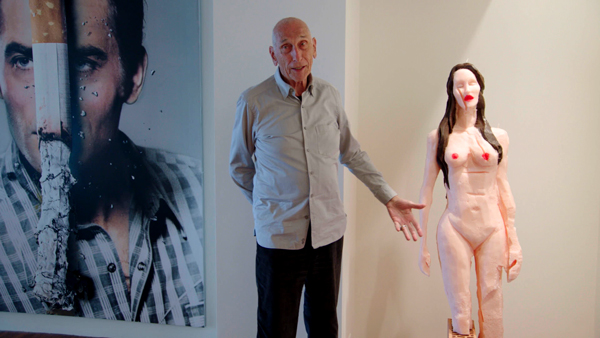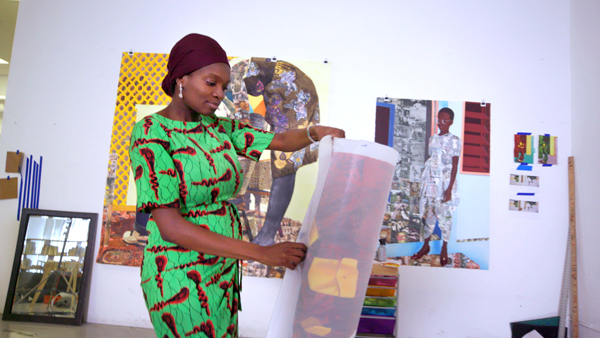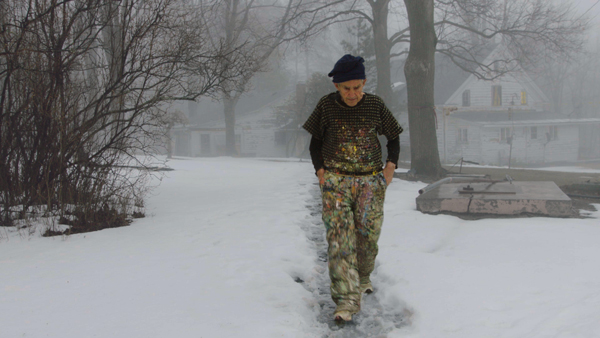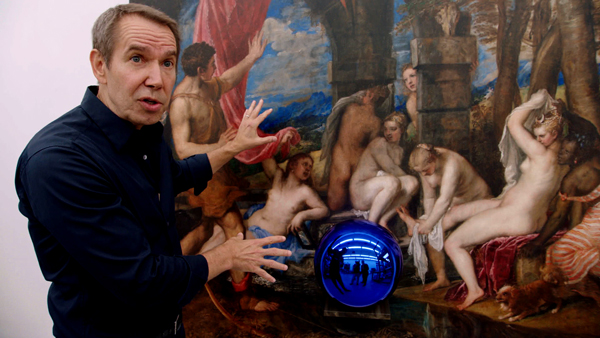As we raked through ashes in California, reminded that we had already entered an anthro-obscene geological epoch, the most “important” of the Fall 2018 art auctions were already taking place, with records dropping every step of the way—Hopper, Hockney, Jack Whitten, Jacob Lawrence (with unusual drama), even our own Henry Taylor. But as any stand-up comedian or Sotheby’s own Amy Cappellazzo will tell you—it’s all about timing. Which is why HBO had the good sense to drop Nathaniel Kahn’s The Price of Everything into theaters around the 45th anniversary of the 1973 Scull collection auction, and across its cable platform just before the first major auctions.
The title is a bit of a feint, a distraction from the real action which plays out off-camera (and arguably outside the art world altogether), which is both its attraction and (to a minor extent) disappointment. What saves the film is an awareness of its limitations, a rhythm and pacing reminiscent of documentaries like R.J. Cutler’s The September Issue (2009), which tracked the dynamic yet conflict-riddled editorial process leading up to the publication of the September 2007 edition of Vogue, and some, well, priceless moments that played out the tragicomedy of values under the screened action like a string continuo under a brass choir. It doesn’t exactly end with a bang, but then—see auction results above.

4. The collector Stefan Edlis, as seen in “The Price of Everything.” Courtesy of HBO
Can it really be much of a surprise? The hammer falls, the sales close, and everyone moves on to the next shows, acquisitions, auctions, etc. But as we knew in 2018, the most rational expectation is for the unexpected if not actually catastrophic. The fire THIS time, as James Baldwin might have put it. To his credit, Kahn and most of the major players featured in the film (with the possible exceptions of Jerry Saltz and Jeff Koons) have some idea of where it’s all heading, but continue to perform their roles, not always aware (as in the Wilde play that inspired the title) of the extent to which they embody the dubious values and verities of this world in varying degrees of conflict and alignment.
Paul Schimmel and Gavin Brown actually give voice to this underlying reality, but Kahn is content to leave what Schimmel correctly identifies as a “bubble” floating. Brown in turn sees the “edge” the art world is careening towards (“I can smell the smoke!”), but seems helpless to do anything but drift along with the tide of the commercial cycle. He’s a part of this world, too—with artists of his own to promote and a business to run.
What the film skirts, and is only partially in play in most of the major fall and spring auctions, but can be glimpsed in the film’s interstices and certainly felt throughout, is the real passion animating this commerce: the thrill of the chase. The excess of contemporary commercial culture is sufficiently developed here. What we don’t see is the passion, even obsession, behind the quest to find and possess these objects. But this passion animates collecting at every level of the art market, and not just the upper reaches of the auction market that really take in no more than a few hundred collectors.

9. The collector Stefan Edlis, as seen in “The Price of Everything.” Courtesy of HBO
This is something that can’t always be quantified or laid out on a spreadsheet (we catch collector and philanthropist Stefan Edlis doing just that at one point in the film)—which is presumably why Kahn turns to former ABC producer and sometime social satirist (The Manny) Holly Peterson, who also happens to be something of a collector. Peterson can see where this crosses over from fashion or mere social status-seeking to serious neurosis. But we don’t need a chart-busting balloon-dog to see that at the upper reaches of this market, this clearly crosses over into something akin to social pathology. Have a look at the sales results from the November contemporary auctions, and you can see that for quite a bit less than $60 to $90 million, you could take home an entire collection of market-approved blue-chip (and some actual first-rate) art.
There’s a certain retail glamour to big art-auction evenings—and they usually are evenings, traditionally in May and November, usually in New York and London. But the glamour lasts about a minute. These are fairly businesslike proceedings and the auctioneers move through the lots briskly. There are big auction dates in other cities, too; but in the art world, these are the most visible, high-profile sales where the most highly valued lots tend to be aggregated, frequently around a major estates liquidation or collector’s de-accessioning, but usually including more than one major slice of what we might call legacy holdings. This is where you find a kernel of truth in Simon de Pury’s simultaneously grand and crass summation, “It’s very important for good art to be expensive.”

2. The artist Njideka Akunyili, as seen in “The Price of Everything.” Courtesy of HBO
The distinction we might draw is durational: before mid-20th century, the works of art that changed hands at these stratospheric levels were not only masterpieces but held over a span of one or more generations. The overheated and inflated postwar and contemporary art-auction market has completely distorted otherwise rational economics. Now the lot considered for sale may have been held only a few years. It may or may not be about a collection or collecting—or even flipping. The seller may simply be cashing out, entirely disengaging from the market or re-entering it at another level. What we increasingly see now is something more on the order of a NASDAQ for, let’s say, recent public offerings, as opposed to holdings—with fashion and sheer speculation taking the place of substantive criteria.
One of the treasures of the Kahn documentary is the archival footage of the October 1973 auction of the Scull collection of late 1950s abstraction, Pop and Minimalist art. It’s a vivid slice of Manhattan social as well as art history—the “Scene” moved uptown. But the 1973 Scull auction did not by itself trigger the escalating speculation in the contemporary art market that followed; and as usual, there’s a back story: the Sculls’ marriage was on the rocks. Within a year, Ethel filed for divorce (a story all by itself).

3. Sotheby’s Amy Cappellazzo, as seen in “The Price of Everything.” Courtesy of HBO
The thrill of the chase is still there—just ask Sotheby’s Executive Vice President and Contemporary Art Chairman, Amy Cappellazzo, whose brand is on abundant (and entertaining) display in the Kahn documentary. But in the late-capitalist auction marketplace, it’s given way to something else. Call it the frenzy to disown, the fear of missing the cultural ‘sell-by’ date. It’s not about the prize, the masterpiece, the collection. It’s about currency—and you can always find a trade war if you want to look for one in that marketplace.

8. The artist Larry Poons, as seen in “The Price of Everything.” Courtesy of HBO
“How do you stay sane when your paintings go for a million dollars at auction?” Marilyn Minter asks, half-surprised even to be alive to see it. Kahn’s documentary paints Larry Poons as the artist in voluntary self-exile from the commercial circus of the New York art world, pursuing the elusive grail of his vision. But Minter’s career is far more instructive with respect to the caprices of both commerce and culture. Although Minter’s work has been striking from her earliest, quasi-experimental work, only in 1995 did it begin to reach the platform it long deserved. Poons, by contrast, was immediately successful, debuting at Green Gallery and eventually moving to Castelli; and his comeback has been well underway in this century. As Kahn’s documentary closes, Poons walks uptown from a festive opening at his Manhattan gallery, not incidentally passing a shop window displaying licensed merchandise by Jeff Koons. It’s the slow exhale on the film—and a chapter in the culture of late capitalism spinning out of control in plain view. Kahn’s film puts an ironic lens on what might have been a satyricon of serial excess. But you can’t argue with supply and demand. Or can you? Barbara Rose seems to here. Even Phillips’ Chairman Edward Dolman sounds a cautionary note (en route to a $1 billion year for the house): “[T]here’s a temptation for artists to over-produce.” Although Kahn can’t show us all aspects of even the auction market, between Poons, Minter and several others, he gives us a fair circumnavigation of its northern latitudes from the artist’s viewpoint.
There isn’t a lot Amy Cappellazzo doesn’t know about selling art. Her attitude and approach were well documented in Sarah Thornton’s 2008 trans-sectioning in Seven Days In the Art World. We pick up a few more angles on it as she runs through “comps” with an assistant putting together an auction catalog. But it’s not as if Cappellazzo (or Kahn himself) doesn’t comprehend the larger cultural context and the imponderables concealed within the market calculus. It’s only becoming more complicated as we begin to see works that inhabit the gray zone between object or document and performance entering the market: performance works sold to institutions and in the secondary market, works produced by artificial intelligence.
But the chase only takes you so far. It’s in the enduring proximity afforded by possession where the “grail” mythos (or Pandora’s box) unlocks its secrets. Cappellazzo is not exaggerating when she says “[a] painting like that could change your life—if you let it.” We feel the double freight of that line. It’s the curse of the Hope Diamond magnified into full-scale Shakespearean tragedy. It’s in these moments where we glimpse the more incalculable values prized from the interstices of these transactions. So why not “keep it floating”? It’s the only place we want to live.


